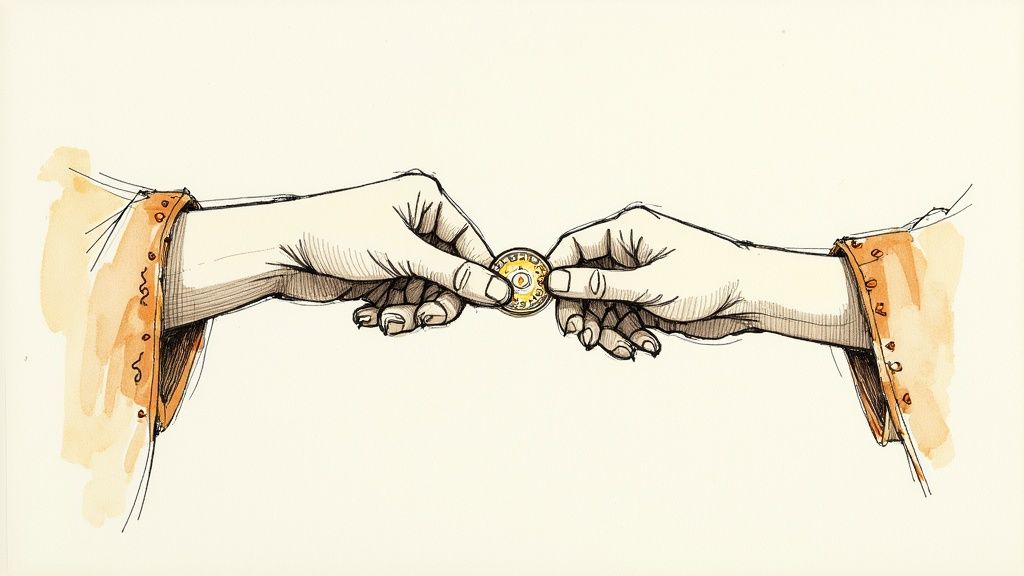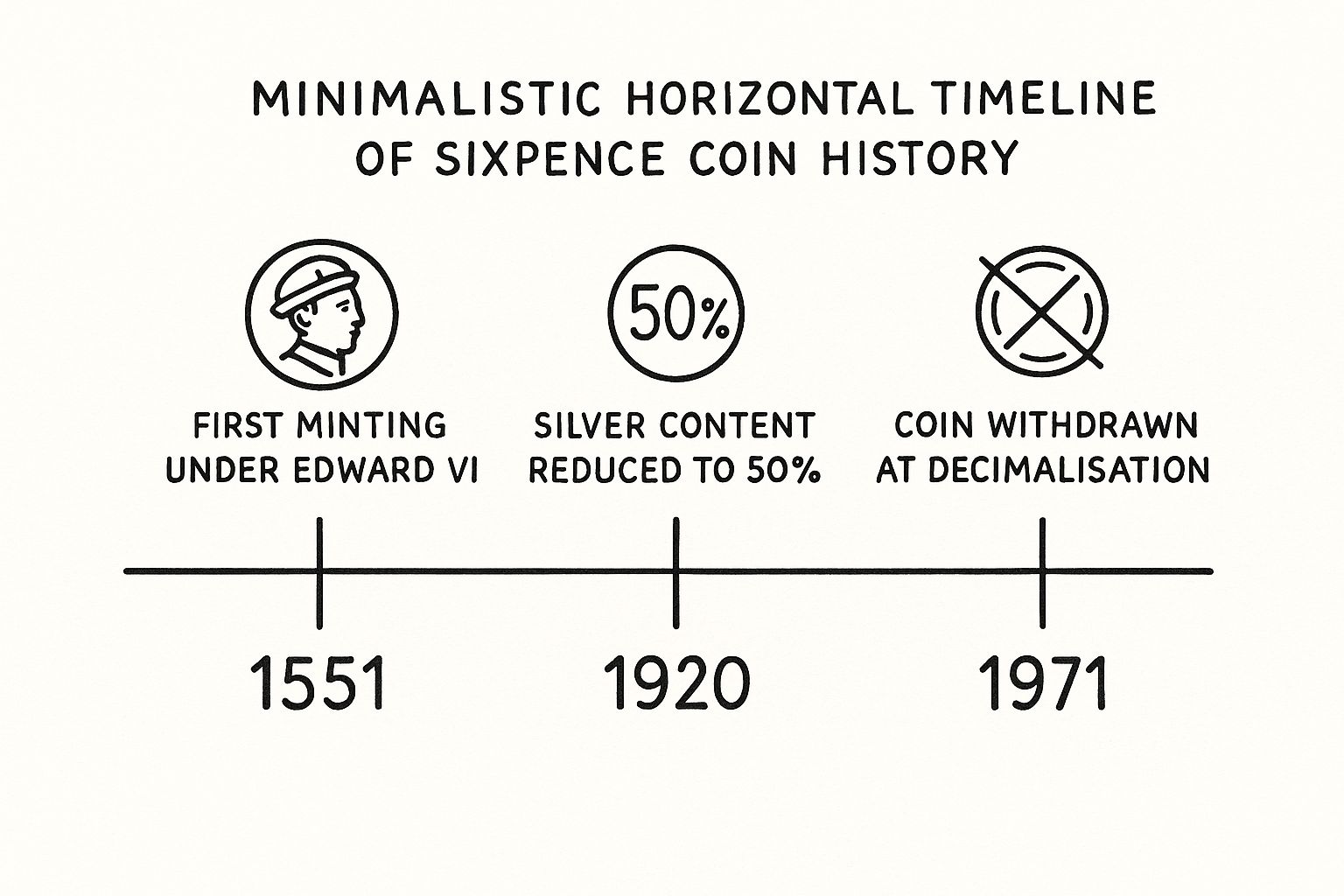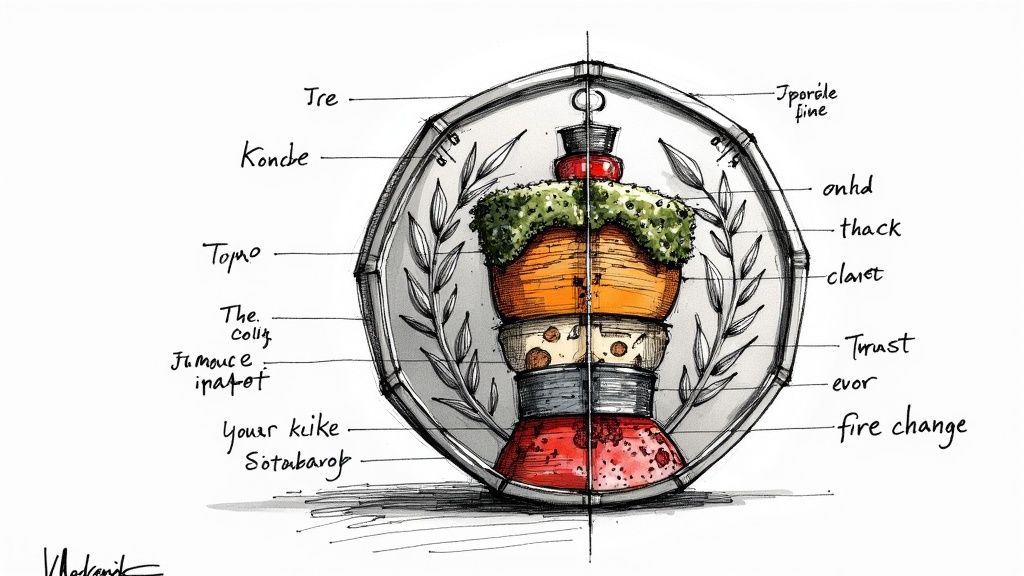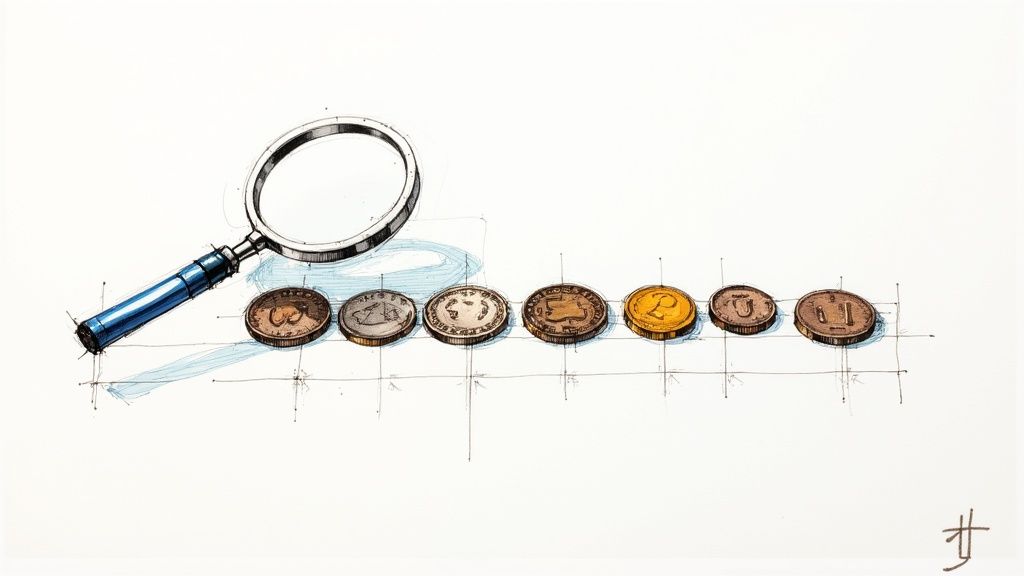Wondering what that old sixpence tucked away in a drawer might be worth? The answer can be anything from less than a pound to several hundred, and it all boils down to its age, what it’s made of, and its condition. Most of the sixpences you’ll find from after 1946 are made of cupronickel and are worth a couple of pounds at most. But the older coins, especially those containing 92.5% sterling silver, are a different story entirely and can be highly prized by collectors.
Your Quick Guide to Sixpence Coin Values

Before we get into the nitty-gritty of coin grading and rare dates, let’s get a quick feel for what your sixpence could be worth. Think of this as your starting point, a way to get a rough idea before we explore the finer details. The story of the sixpence is a fascinating one, told through the very metal it was struck from, reflecting Britain's economic ups and downs over hundreds of years.
The single biggest factor driving a sixpence's value is its composition. For most of its long history, the coin was made of silver, giving it an inherent precious metal value. That all changed after the Second World War when economic realities forced a change.
Key Value Tipping Points
Understanding these key dates is the first step to figuring out what you have.
- Pre-1920 Coins: From a metal perspective, these are the most sought-after. They contain a hefty 92.5% sterling silver, meaning their value is underpinned by both their silver content and their history.
- 1920-1946 Coins: During this period, the silver content was slashed to 50%. They're still valuable and contain silver, but they aren't as prized as their sterling predecessors.
- Post-1946 Coins: From 1947 right up until the last one was minted, the sixpence was made from cupronickel (a mix of copper and nickel). These coins have no precious metal value, so their worth comes down purely to their condition and how collectible they are.
To give you a more practical idea, the table below lays out some typical value ranges for common-date sixpences in average circulated condition. Just remember, these are just ballpark figures. If you have a rare date or a coin that looks like it just left the mint, it could be worth a great deal more.
A coin's journey through time is etched onto its surface. While a shiny, new-looking coin is appealing, collectors often prize the natural patina that tells a story of its circulation, making condition a critical—and nuanced—part of its final value.
Estimated Sixpence Values by Key Era
This table shows estimated values for common sixpence coins in average circulated condition. Rare dates or coins in uncirculated condition can be worth significantly more.
| Era / Monarch | Years of Issue | Metal Composition | Typical Value Range |
|---|---|---|---|
| Early Silver (Victoria) | 1838–1901 | 92.5% Silver | £5 – £50+ |
| Edward VII & George V | 1902–1919 | 92.5% Silver | £3 – £20 |
| George V & George VI | 1920–1946 | 50% Silver | £1.50 – £8 |
| Post-Silver (Elizabeth II) | 1953–1967 | Cupronickel | £0.50 – £3 |
As you can see, the shift away from silver had a dramatic impact on the coin's base value. A Victorian sixpence has a strong foundation of value from its silver alone, whereas a 1960s sixpence relies almost entirely on a collector's interest.
The Story of the Sixpence Through British History
To really get a feel for a sixpence’s value, you have to look beyond the metal and dig into its incredible story. This little coin is a time capsule, a real piece of British history that has seen nearly five centuries of change, from Tudor monarchs right up to the modern day. Its journey is a perfect mirror of the nation's own economic and social tides.
The story kicks off in 1551, with the young King Edward VI on the throne. The kingdom's finances were in a real mess, mostly because his father, Henry VIII, had debased the silver coinage. The silver testoon, once worth a solid twelve pence, had seen its value plummet. Something had to be done to restore public confidence, and that something was a brand new, reliable coin: the sixpence, struck from high-quality sterling silver.
A Reflection of Britain's Fortunes
Right from the start, the sixpence was a symbol of stability, containing 92.5% silver. For over 350 years, it was a dependable part of everyday life, acting as half a shilling in the old £sd (pounds, shillings, and pence) system. You can get a broader sense of these shifts in our article on the brief history of British coins.
But the immense economic pressure of the First World War forced a dramatic change. In 1920, the silver content was slashed to just 50%. This wasn't a random decision; it was a direct response to soaring silver prices and the mountain of national debt, marking a huge turning point for the coin. The final chapter of its silver story came after the Second World War, another period of intense economic strain.
A sixpence's metallic composition is like a historical barometer. A shift from sterling silver to cupronickel isn't just a change in material; it tells a story of post-war austerity, economic necessity, and a nation having to adapt to a new reality.
This timeline infographic helps visualise the key moments in the sixpence's long and storied history.

As you can see, major world events had a direct impact on the coin's physical makeup, which is a crucial factor for collectors trying to determine its value today.
The End of an Era
From 1947 onwards, all newly minted sixpences were made from cupronickel, an alloy of copper and nickel. For the first time, silver was removed from the coin entirely. This introduction of a silver-free coin was a pragmatic decision, pure and simple, driven by the needs of the post-war economy.
Even with all these changes, the British public's affection for the "tanner" or "sixpenny bit" never faded. It was so well-loved that even after the massive switch to decimal currency on Decimal Day in 1971, it wasn't immediately pulled from circulation.
While most of the old coins vanished, the sixpence—now revalued at 2.5 new pence—remained in use thanks to popular demand. It was finally demonetised in 1980, but this unique legacy adds hugely to its cultural and collectible appeal, directly influencing what a sixpence coin is worth today.
How to Identify and Value Your Sixpence

Working out what a sixpence is worth is a bit like being a detective. You're piecing together clues from its past to uncover its story and its value today. It’s about more than just a quick glance; you need to look at its age, what it’s made of, the monarch on the obverse, and the life it’s lived.
Let's break this down into four simple, practical steps. Think of this as your valuation checklist, turning what seems like a complex task into a straightforward assessment. By looking at each factor, you can build a complete picture of your coin and understand why some are worth a few pence and others are genuine collector's items.
Date and Rarity: The Scarcity Factor
The first and most obvious clue on any coin is its date. This single piece of information is your gateway to understanding just how rare it is. Think of it like a limited edition print; the fewer that were made, the more desirable they become.
For most years, the Royal Mint churned out millions of sixpences, making them quite common and easy to find. However, certain years had much lower mintages, perhaps due to economic pressures, wars, or other major historical events.
A standout example is the 1952 sixpence. It was minted just before King George VI's death, but very few were ever produced, and most of those were intended for overseas territories like Jamaica. Finding one is exceptionally rare, making it one of the most valuable sixpences a collector can own.
Metal Content: Silver or Not?
As we've seen, what a sixpence is made of is a huge driver of its base value. Your main job here is to figure out if your coin is silver or the later cupronickel. Luckily, the date is your best friend.
- Pre-1920: Your coin is 92.5% sterling silver. These older coins have a distinct, slightly softer lustre and feel a bit heavier than their later counterparts.
- 1920-1946: The coin is 50% silver. It still holds precious metal value, just not as much as the sterling versions.
- 1947-1967: The coin is made from cupronickel (a copper and nickel alloy) and contains no silver at all. These often have a shinier, more modern look.
A quick check of the date is usually all it takes to separate the silver treasures from the everyday currency. This is probably the most important first step to understanding your coin's potential value.
Monarch and Design: The Collector's Choice
The monarch featured on the "heads" side of the coin also plays a part. While every monarch from Edward VI onwards has appeared on a sixpence, collector demand often zeroes in on specific reigns.
Victorian-era sixpences, for example, are very popular because of their age and their connection to such a significant period in British history. Coins from very short reigns, like Edward VIII (though none were officially put into circulation), are the stuff of numismatic legend. The design on the reverse can also add to a coin's appeal.
A coin's condition is its autobiography. Every scratch, every bit of wear, and every patch of patina tells a story of where it's been. Unlike most antiques, 'restoring' or cleaning a coin erases that story and, in the process, destroys most of its collectible value.
Condition and Grading: The Final Multiplier
Finally, we arrive at the coin's physical state—its condition or grade. This is where the value can be dramatically multiplied. Imagine you have two identical 1925 sixpences. One is worn smooth from decades of changing hands, while the other looks almost as if it just left the mint. The second one will always be worth significantly more.
If you'd like to dive deeper, you can learn more about the principles of coin valuation in this comprehensive guide on how to value coins.
Collectors use a detailed grading scale, but you can get a good idea with these simple terms:
- Fine (F): The main design elements are visible, but the coin shows significant wear.
- Very Fine (VF): More detail is present, with clearer lettering and designs.
- Extremely Fine (EF): Only light wear is visible on the highest points of the design.
- Uncirculated (UNC): The coin looks as it did the day it was minted, with no signs of wear at all.
A common coin in Uncirculated condition can often be worth more than a rarer date in poor condition. And always remember the golden rule of coin collecting: never clean your coins. Doing so can drastically reduce their value.
Discovering Rare and Valuable Sixpence Coins
Now that we’ve got the theory down, let’s get our hands dirty and look at some real treasures. It’s one thing to talk about mintage figures and grading, but seeing actual examples makes it all click into place.
We're about to spotlight a few highly sought-after sixpences, connecting their unique stories and scarcity directly to what they fetch on the market. This isn't just about memorising dates; it’s about understanding the history that turns a simple piece of silver into a collector's prize.
Victorian Era Young Head Sixpences
One of the richest hunting grounds for collectors is the long and storied reign of Queen Victoria. Her "Young Head" sixpences, struck between 1838 and 1887, are especially popular. It’s easy to see why—their age, high silver content, and direct link to a transformative period in British history make them a classic favourite.
While these coins aren't exceptionally rare for most years, the real challenge is finding one in top condition. Think about it: these coins passed through countless hands for decades, so most are heavily worn. A well-preserved Victorian sixpence, however, can easily command £20 to £75. That’s a huge leap from its basic silver value and shows just how much collectors will pay for quality. You can find more details on the value of Victorian-era sixpences on headsandtailsjewellery.co.uk.
A historic coin's value is often a balancing act between how many were made and how many survived in good shape. Millions of Victorian sixpences were minted, but very few made it through the hustle and bustle of daily life without getting worn down, creating real scarcity for high-grade examples.
The Legendary 1952 George VI Sixpence
If there’s one "holy grail" for modern sixpence collectors, it has to be the 1952 issue. This coin’s story is a perfect storm of history creating incredible rarity. King George VI died in February 1952, and just like that, the production of coins with his portrait came to a screeching halt.
Here's the crucial part: not a single sixpence from that year was ever released for circulation in the UK. The only ones made were a small batch intended for overseas territories, mainly Jamaica. This twist of fate makes finding a 1952 sixpence incredibly difficult, cementing its status as one of the rarest sixpences out there. Depending on its condition, its value can run into hundreds, or even thousands, of pounds.
This famous rarity is a great reminder that plenty of other scarce dates are waiting to be found. To learn about other key coins, you might be interested in our guide to the 7 rare UK coins every collector should know. It just goes to show that a coin's value is deeply tied to its unique story and scarcity—and that’s what numismatics is all about.
The Sixpence in Everyday British Life

To really get a feel for the sixpence, you have to imagine a time before contactless payments and calculators. In the wonderfully complex world of pre-decimal currency, the sixpence wasn’t just loose change rattling in a pocket; it was a workhorse coin, a vital cog in the machine of daily British commerce.
Picture it: a monetary system not based on neat, easy units of ten. The old British currency was a mix of pounds (£), shillings (s), and pence (d). One pound was made up of 20 shillings, and each shilling was worth 12 pence. That meant a single pound contained 240 pence—a far cry from the simple 100 we use today.
In this intricate system, the sixpence played the role of a perfect middleman. At half a shilling, it neatly bridged the gap between the small pence coins and the much larger shilling, making everyday transactions run that much more smoothly.
Navigating the £sd System
The sixpence was an essential piece of the UK’s pre-decimal puzzle. Being worth half a shilling made it exactly 1/40th of a pound, a fraction that proved incredibly practical for daily life from the 16th century all the way up to 1971. You can dive deeper into the nuts and bolts of the pre-decimal system on allcoinvalues.com.
This system demanded some sharp mental arithmetic for even the most basic shopping trips:
- Paying for a loaf of bread that might cost fourpence.
- Buying a pint of milk for eightpence.
- Working out the correct change from a shilling.
The sixpence made these sums far more manageable for everyone, from the local shopkeeper to the schoolchildren spending their pocket money. Its sheer utility cemented its place in the nation’s heart.
The sixpence wasn't just a coin; it was a cultural touchstone. Its enduring presence in traditions like wedding shoes and Christmas puddings speaks volumes about the affection people held for it, adding a sentimental value that money can't measure.
Decimal Day and the Public Outcry
On 15 February 1971, a day now known as Decimal Day, Britain's currency was dragged into the modern age. The pound was simplified to be worth 100 "new pence," and the old coins were slowly phased out. The sixpence, however, was given a new lease of life and revalued at 2.5 new pence.
The public's affection for their beloved "tanner" was so strong that a major campaign, "Save the Sixpence," was launched to keep it in circulation. Astonishingly, the public pressure worked. The sixpence remained legal tender for almost another decade before it was finally demonetised in 1980, truly marking the end of an era.
This uniquely extended lifespan is a powerful testament to just how important the coin was to the British people and its cherished status in daily life.
Common Questions About Sixpence Coins
As we wrap up our journey through the world of the sixpence, it’s a good time to tackle some of the questions that pop up most often. Whether you’re just starting out or have been a collector for years, these answers should clear up a few things and give you some practical advice.
Are All Sixpence Coins Made of Silver?
No, they’re not, and this is probably the single most important detail to get right when figuring out a sixpence’s value. The metal used to mint these coins changed dramatically over the years, and the date on the coin tells you everything you need to know about its precious metal content.
Only sixpences struck before 1947 contain any silver at all. Here are the key dates to remember:
- Pre-1920: These are the most sought-after from a metal perspective. They are made of 92.5% sterling silver.
- 1920-1946: The silver content was almost halved during this period, dropping to 50%.
- 1947 onwards: From this point on, all sixpences were minted from a copper-nickel alloy called cupronickel. These coins have no silver content, so their value comes purely from their condition and collectability.
What Is the Lucky Sixpence Tradition?
Ah, the "lucky sixpence." This is a wonderful, deep-rooted British tradition that gives the coin a special place in people's hearts. You’ve most likely heard it in the old wedding rhyme: "Something old, something new... and a silver sixpence in her shoe." This lovely custom was believed to set the bride on a path to a happy, wealthy, and fortunate life.
But it wasn't just for weddings. Finding a sixpence in your portion of Christmas pudding was said to bring you good luck for the next twelve months. The coin was also a classic gift for christenings. This enduring cultural role means the sixpence is often wanted for reasons far beyond coin collecting.
The cultural weight of the 'lucky sixpence' tradition often creates a demand that transcends numismatic value. Many people seek out these coins not for their rarity or condition, but for the history and sentiment they represent, especially for weddings and anniversaries.
Does Cleaning a Sixpence Increase Its Value?
This is an easy one: absolutely not. In fact, it’s one of the worst things you can do. In the world of coin collecting, cleaning a coin is a cardinal sin that can permanently destroy its value.
Experienced collectors value a coin’s natural patina—that subtle toning and surface change that only develops over decades or centuries. This patina is like a coin's fingerprint; it proves its age and tells the story of its life. Cleaning strips all that history away, leaving behind microscopic scratches and an unnatural, polished look that any serious buyer will spot from a mile away. The best advice is always to leave your coins as you found them.
How Should I Sell My Sixpence Coin?
The best way to sell really depends on what you have. For common, circulated cupronickel sixpences or silver coins in rough shape, online marketplaces like eBay are a great bet. You’ll reach a wide audience of casual collectors, history buffs, and people looking for a "lucky" coin.
However, if you think you have something special—perhaps a rare date like the 1952 issue or a coin in fantastic condition (Extremely Fine or Uncirculated)—you need to take a different approach. For these potentially high-value pieces, your best move is to talk to a reputable coin dealer or a specialist auction house. They can give you a proper appraisal and connect you with serious collectors who are prepared to pay a premium. Whatever you do, always take clear, well-lit photos of both sides of the coin before you sell.
At Cavalier Coins Ltd, we are passionate about connecting collectors with the pieces that complete their collections. Whether you're searching for a lucky sixpence for a wedding or a rare date to add to your portfolio, explore our extensive selection of world coins and banknotes at https://www.cavaliercoins.com.

